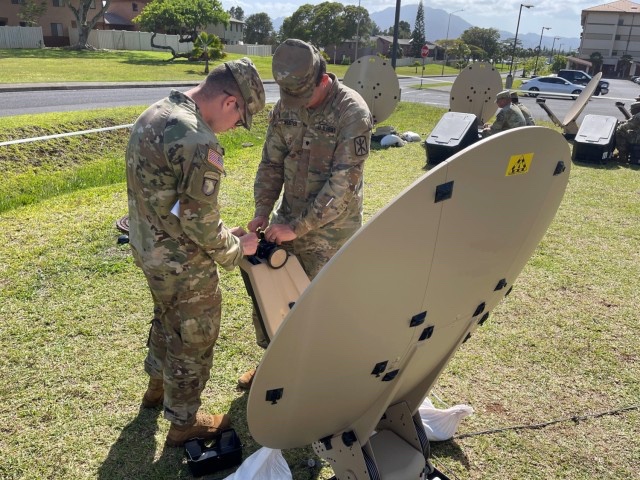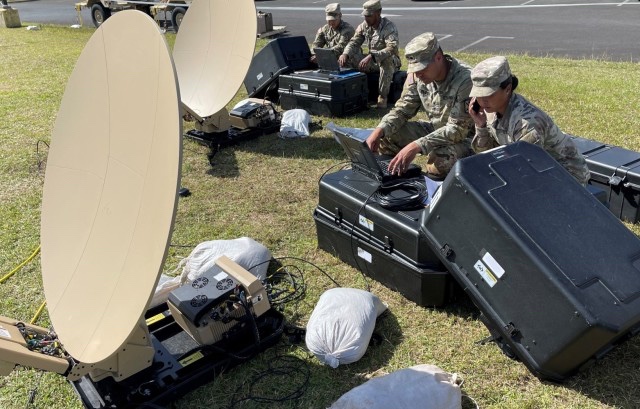
HELEMANO MILITARY RESERVATION, Hawaii — As the 307th Expeditionary Signal Battalion, or ESB, celebrated its 80th birthday on May 27, the Army is converting the unit to an ESB-Enhanced formation. With this conversion comes a smaller, lighter and faster network communications equipment tool suite that will better serve the unit’s unique and varied mission sets.
With companies in both Hawaii and Alaska, the battalion provides global network connectivity on short notice to U.S. Army Pacific and U.S. Army North units, often in harsh locations, from secluded island jungles thousands of miles across the ocean to ice-covered mountains in the Arctic Circle.
“We talk about the tyranny of distance, about the challenges created by the vast number of locations and extreme environments throughout the Pacific; this new expeditionary equipment set will help us to support those missions,” said Col. Lee Adams, commander of the 516th Theater Signal Brigade, to which 307th ESB-E is assigned. “We are always trying to improve and to provide foundational capabilities for the theater Army. This transition to an ESB-E does that for us; it gives us a better capability to enable the theater Army to fight successfully.”
The reduced size and system complexity of the equipment set enables ESB-E units to significantly increase their network support to other units with more nodes and less manpower, while reducing transportation requirements by over 60 percent. The tool suite includes various-sized expeditionary satellite dishes and baseband equipment, high-throughput backhaul radios, and wireless command post technologies. It replaces the unit’s much larger Tactical Network Transport At-The-Halt equipment, formally known as Warfighter Information Network-Tactical, which is often transported across the Pacific via cargo ships. The new equipment set can be transported via commercial airline if needed, in hours versus days or weeks.
Prior to his current position, Adams commanded the first unit to be converted to an ESB-E, the 50th ESB-E, during the planning and initial fielding of the unit’s pilot equipment. The 307th ESB-E conversion marks the sixth unit that the Army has fielded with the new equipment package. The Army’s Project Manager Tactical Network, assigned to the Program Executive Office for Command, Control, Communications-Tactical, began fielding the unit with the Scalable Network Node to the companies in both Hawaii and Alaska in March. Fielding the remainder of the initial baseline systems is expected to be complete by the end of the fiscal year.

The Army’s agile ESB-E acquisition and fielding approach aligns with its two-year incremental Capability Set fielding process, which enables the service to enhance the ESB-E baseline capability in future capability sets if Soldier feedback warrants it, or when evolving commercial technologies become mature enough to be procured. On the current plan, the Army is fielding several ESB-Es per fiscal year until all of the ESBs have been upgraded to the new baseline capability.
“As I talk to the other ESB-E commanders, the [project manager], and its fielding team that is here now, and we get feedback from our Soldiers as they going through the training, I can see firsthand the accumulation of lessons learned and how the equipment set continues to improve,” said Lt. Col. Drew Chaffee, commander of the 307th ESB-E, who also once served as a company commander for the unit.
The ESB-E tool suite is a critical element of Capability Set 21, which delivers smaller, lighter and faster communications systems that are easier to operate and provide increased network communication Primary, Alternate, Contingency and Emergency, or PACE, plan options. The tool suite provides signal path diversity in congested and contested environments, leveraging numerous high-throughput line-of-sight and beyond-line-of-sight capabilities.
“It’s critical to have a good PACE plan, to be able to incorporate different transport that may be more survivable in a particular terrain. Every commander wants more options,” Adams said. “When we are fighting in a battle environment that is degraded, intermittent or just has delayed latency, I have to have different technologies, different pieces of kit that make me more survivable, make us a harder target to hit, yet allows us to stand still to support multi-domain operations at an assured level. And that is what having these different network transport capabilities provide us.”
To enable additional transport paths for improved network resiliency, the Army is working to deliver high-throughput and low latency satellite communications leveraging emerging commercial technologies and services in non-traditional orbits, such as Low Earth Orbit and Medium Earth Orbit. In April, the 307th ESB conducted a demonstration of commercial high-throughput and low latency satellite communications, at the Helemano Military Reservation on Oahu. The unit plans to further experiment with the capability during upcoming U.S. Army Pacific training exercises.
“The name of the game is operational flexibility,” Chaffee said. “This new kit is scalable and tailorable to the mission. We have the operational flexibility to tailor our teams, our equipment set, and our footprint to the requirements based on the mission and the environment that we find ourselves in. This smaller lighter ESB-E kit is going to get us there much more effectively and it highlights the United States’ ability to support and adapt in some of the most austere and remotely located environments in the world.”
By Amy Walker, Project Manager Tactical Network, PEO C3T, public affairs

